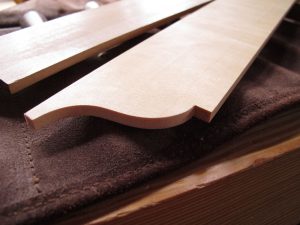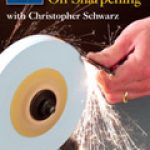We may receive a commission when you use our affiliate links. However, this does not impact our recommendations.
While deep into dovetailing a small chest at the Connecticut Valley School of Woodworking this summer, my concentration was suddenly burst by someone at my workbench.
“There’s a guy outside,” the student says, “and he’s selling all his woodworking stuff.”
I nodded and then returned to my dovetails. I run into people all the time trying to sell me their woodworking gear – curiously it almost always involves a Shopsmith. And the last thing I’m in the market for are tools (see “The Anarchist’s Tool Chest”).
A few minutes later another student approached my bench and said the guy had some “crazy wood” and was retiring from his career as a luthier.
OK. I put down my tools.
The newly minted “retiree” was probably 25 years old and was pulling out tools and slabs of wood and depositing them on the school’s picnic tables. For the most part, nothing coming out of his van did anything but make me feel sad – sad for the craft and this unusual guy.
He asked Bob Van Dyke, the director of the school, if he could hang out and sell his stuff. Bob looked over the tools, picked out a few things for himself and agreed.
I went back to my dovetails.
That afternoon the retired luthier showed up at my workbench with a couple pieces of wood and asked me to take a look. They didn’t look promising. Both small slabs had met with disaster on the band saw. They were barrel-shaped, probably from an under-tensioned blade. And they varied in thickness from 1/8” to 7/8” in points.
Firewood, I thought.
But then he said the two magic words: huon pine.
This slow-growing tree (Lagarostrobos franklinii) is found in Tasmania, Australia, and is as rare and expensive as they come. It was over-harvested because of its amazing physical properties and is now a protected and expensive species. Even the shavings are sold for their intoxicating smell or bug-deflecting properties.
One of the students had grown up in Australia and I asked him to confirm that this stuff was huon pine. After a close inspection, he said he was certain that it was.
How much? The guy wanted $20. Before he could take another breath I had my wallet out.
That slab of huon has sat in my wood rack since the summer, awaiting inspiration. This morning, I looked over the slab and made a few measurements. This board, which easily took 400 years to grow, was going to become a Roubo try square.
The thick parts will be the stock. The thin parts will become the blade. I went to work with a handsaw, jointer plane and my band saw.
Within a minute the shop filled with the most intoxicating scent I’ve encountered in the craft. It’s a bit spicy, but there’s more to it – think well-worn leather in an old bookstore.
After shaping the blade before lunch, I counted the growth rings on the 2-5/8”-wide blade and stopped after 150.
When I finish uploading this blog entry I’m going to go down and complete the stock. Then glue it together. But I don’t want to mask the smell with a film finish. So I’m going to use a little paste wax. After the wax’s smell fades, I’m told the smell of huon pine will return again. And then I can always have a little bit of that smell close at hand in my shop.
— Christopher Schwarz
The Roubo Try Square is one of my favorite projects to build when I have a little time and some interesting wood. You can find the plans for the square in the February 2010 issue of Popular Woodworking, or you can download the expanded plans from ShopWoodworking.com here.
Here are some supplies and tools we find essential in our everyday work around the shop. We may receive a commission from sales referred by our links; however, we have carefully selected these products for their usefulness and quality.










Chris,
I read some where you were translating the works of A.J. Roubo into English. If so, is there a publication date or is it already out?
Tom III
Chris,
I’m just finishing up the book, glad to see you living by what you write (‘And the last thing I’m in the market for are tools’).
Over here in Aus we have some fantastic wood, but sadly most of what we can find at the timber yards is construction grade pine and fir, with the good Aussie hardwoods being available in decking sizes only. I’ve been lucky to find a local place that gets a lot of hardwood as packing material and they are more than happy to save me the excess, and it’s insanely beautiful once cleaned up.
Before you write your next book ‘Smells of the workshop’ make sure you head down here and get a whiff a nice old piece of gum tree :).
Andrew
Chris,
Sometime it would be nice to see an article on using the Roubo try square. You’ve written lot’s about making one, but would appreciate some insights on use, tricks, etc. Happy Thanksgiving to you and your family.
Really, is this what we evolve into? Thousands of hours in learning and practicing, thousands of dollars in tools, and we’re putting shavings into little bags? We’ve become makers of potpourri?
I bought a couple pieces off him, including a really incredible piece of figured cedar, which will become a drawer front once I get to that project. Much of what he had was in such sorry shape it was tough to find anything to do with it.
The piece of purpleheart I got makes me wonder why I bought it (I’m mostly a hand tool user). Ugh, that is some seriously tough wood. I’m thinking of using it for some winding sticks.
I’m with Esincox, the price and availability has now suffered the Schwarz effect, even here in Australia. Glad I have a considerable stack of it hidden away, could sell it all off now and retire very comfortably now that Chris has affected the price.
It is by far my favourite timber, particularly if you get some of the figured birdseye stock. The darker yellow or gold the timber, the denser the wood and the better the scent. Turns beautifully, carves easily and is just wonderful to plane.
Best finish for your square in my view, Danish Oil followed by a good waxing. Over time, the wood will get a deeper and deeper golden colour and thats when the grain becomes more apparent. Magnificent wood. To give others an idea, it could be compared in colour and grain density to English Boxwood, but not as robust on the Janka scale.
And for comparative purposes, $20.00 Australian would buy a block of huon about the size of a couple of decks of cards one on top of the other, roughly.
I have just finished turning a Huon Burl into a nice bowl, I am disappointed I can’t put it out I have developed an allergy to the smell and need to find a home for it, bugger.
The Schwarz find Huon Pine … I’m locking up my stock now. 🙂
Chris, I too am in Australia and it never ceases to amaze me how much of this timber is around. For what is apparently quite rare, there’s a lot available. It is restricted though in that no more trees are allowed to be cut down so the expense is all in the digging up of the logs from the rivers and milling them. Living trees only grow a few mm each year so it’s extremely slow growing but still grows quite big. The oldest sample found was estimated to be around 3,500 years old.
Boats used to be built in huon because the natural oils in the timber protected it from rotting. I’ve also seen entire house frames built in the stuff.
Chris, keep your shavings, put them in a porous bag and place it in your linen cupboard or in your wood storage area. It’ll keep all the creepy crawlies away.
Chris: I live in Australia and I have a piece of Huon that has over 600 growth rings in just 8 inches of wood. It does grow amazingly slowly. It is also notorious for having glue joints fail because of its high natural oil content. You need to glue it as soon as possible after planing the surfaces.
And if you want to continue to enjoy its small, store your square in your tool box – or just put a piece of the wood in there. The smell will slowly intensify in the closed in air so that when you open the lid you will get a sudden nose full of it. If the wood is left out in the open air you will not smell it until you cut it as the smell disperses into too much air space.
The only US wood that I know of that has as strong a smell (though different) is Port Orford Cedar.
And one last thing about our Australian woods is that we have common names for most of them – such as Huon Pine, Kauri Pine, Celery Top Pine, Queensland Walnut, Queensland Maple, Red Mahogany, White Beech, Australian Cedar – and on and on, but not a single one, to my knowledge, is true to its name i.e. the Mahogany is not a true Mahogany, the Maple is not a true Maple, etc. To show you how crazy it gets, our local wood handbook lists 7 different types of Silky Oak, and not only are none of them true to the oak genus of Quercus, but each has a different genus to the others, so they are not even related to each other. It is very confusing to the uninitiated.
Huon is a great wood for drawer sides, with its light colour, greasy nature and wonderful smell. I think you will also find it is pretty stable.
Ah, well… there goes the cost on any remaining huon pine on the market!
Any chance you can send me some of the shavings? 🙂
Don’t take this the wrong way, but I would like very much to sniff your wood sometime. I love the smells from different wood. Fresh walnut is great, I love sugar pine, but my favorite of all is olive. I could turn olive on the lathe all day, just for the smells. It would be great to see what huon pine is like.